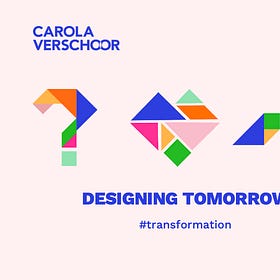Respecting Transformation: Changing Lenses, Changing Outcomes
👓 Rethinking What We See to Redesign What We Do
Transformation is often depicted as a sweeping overhaul: a dramatic change that alters everything overnight. However, true transformation begins not with action, but with a shift in perception. To redesign the systems we inhabit in response to the challenges of a polycrisis -climate change, inequality, technological disruption, and geopolitical instability- we must first adopt a mindset of respect. Not merely as a gesture of reverence, but as re-specting: literally, “looking again” at what we take for granted and questioning our default perspectives. Let’s explore how embracing this lens of re-spect can unlock the potential for transformation design and guide us toward sustainable, human-centered solutions.
Rethinking the Problem: Why Seeing Differently Matters
At the heart of every major challenge is a way of thinking that sustains it. For example, the climate crisis is perpetuated by systems that prioritize extraction over regeneration. Technological disruptions emerge not merely from innovation but from a failure to anticipate human consequences. These crises are interconnected, each amplifying the other. This “polycrisis” requires designers and decision-makers to confront the complex interdependencies shaping our world, which can only happen by stepping outside traditional ways of seeing.
The philosopher Ludwig Wittgenstein noted, “The limits of my language mean the limits of my world.” In design, these limits are not just linguistic but conceptual. Respecting transformation requires us to challenge assumptions, look deeper into the systems driving problems, and embrace ambiguity. For instance, a factory’s carbon emissions are not just an industrial byproduct—they are a symptom of a larger cultural and economic system that values short-term profit over long-term sustainability. Respect demands that we see this system anew, not as an inevitability, but as a choice we can redesign.
Re-specting Systems: How to Shift Perspectives
Re-specting begins with an intentional shift in perspective, a deliberate effort to see what we often overlook. This requires cultivating empathy, curiosity, and humility. The following strategies can help us reframe their understanding of challenges:
Zoom Out to the System Level
Transformation is impossible when we fixate solely on individual problems. By zooming out, we can uncover systemic connections. For example, addressing food insecurity might involve looking beyond supply chains to consider urban design, labor practices, and waste management. Tools like systems mapping and scenario planning can reveal hidden interdependencies, enabling solutions that address root causes rather than symptoms.Adopt Human-Centered Lenses
Technology, policies, and systems should serve people, not the other way around. Respecting transformation means prioritizing diverse human experiences, especially those on the margins. By deeply engaging with affected communities, designers can uncover insights that challenge dominant paradigms. For instance, involving Indigenous communities in sustainability projects often surfaces knowledge of regeneration practices overlooked by frameworks from ‘developed’ countries.Embrace Multiple Perspectives
Complexity thrives on diversity. Transformation requires blending perspectives from disciplines, cultures, and stakeholders. For example, the success of generative AI applications depends on integrating ethical considerations alongside technical innovation. This ensures that tools empower people rather than exploit them.See Challenges as Opportunities
Respect is also about seeing potential in adversity. Constraints often spur creativity, and crises can drive innovation. During the COVID-19 pandemic, businesses reimagined operations, turning remote work into a viable long-term strategy. Similarly, the polycrisis can be a crucible for groundbreaking designs that address interlinked challenges.
Re-specting Design: Small Steps to Big Change
While shifting perspectives is the starting point, transformation also demands action. Large-scale change may feel daunting, but it is the accumulation of small, intentional steps that builds momentum. As designers and doers we can drive transformation by embedding re-spect into every project.
Prototype for Systems Change
Even small experiments can ripple outward. A local initiative to electrify public transit may seem isolated, but its success can inspire broader adoption, influencing policy and infrastructure on a national scale. By testing ideas at a manageable scale, designers can refine solutions while demonstrating their feasibility.Design for Circularity
Instead of creating products that consume finite resources, designers can prioritize circular models. This means rethinking everything—from materials to business models—to ensure that waste becomes a resource. For example, furniture companies like IKEA are adopting circular principles by offering refurbishment services and take-back programs.Measure What Matters
Traditional metrics often fail to capture the transformative impact of design. Respecting transformation involves redefining success to include social equity, environmental health, and long-term resilience. Tools like the Doughnut Economics framework by Kate Raworth encourage designers to aim for a balance between human prosperity and ecological sustainability.Build Coalitions for Change
Transformation is a team sport. Designers must work across silos, partnering with policymakers, businesses, and communities to co-create solutions. Collaboration amplifies impact, ensuring that interventions are both scalable and inclusive.
The Transformative Power of Respect
Re-specting is more than a mindset—it is a methodology for redesigning our world. By looking differently at challenges, we can uncover opportunities to create systems that are not just functional but flourishing. This philosophy aligns with design principles that prioritize adaptability, human dignity, and environmental harmony.
The transformation design ethos recognizes that small actions, when aligned with a vision of systemic change, can create a ripple effect. A single project designed with respect for human and ecological systems can inspire others, gradually shifting entire industries and systems.
In a world defined by interconnected crises, transformation is not a luxury—it is a necessity. But it cannot happen without re-specting the systems, people, and possibilities that surround us. By adopting a lens of curiosity, empathy, and innovation, we can redesign not only our products and services but also our way of being in the world.
In the words of artist Marcel Duchamp, “I force myself to contradict myself in order to avoid conforming to my own taste.” Let us force ourselves to re-spect, to challenge the familiar, and to embrace the transformative potential of seeing differently. Only then can we design a future that thrives.
If you enjoyed this article, please leave a ‘♡’ and/or share it with others. You may also like:
Designing Tomorrow -beyond the Liminal
TL;DR: Systemic collapse is everywhere, and the challenges it brings are opportunities for creativity and transformation. Embracing uncertainty and questioning assumptions can lead to collaborative solutions. Diverse perspectives are essential for navigating complexity and designing a better future. Profound transformation forms out of questioning what …
Transforming Design Thinking: a conversation with Dr. Maria Camacho
TL;DR: In an engaging conversation with Dr. Maria Camacho, we explored the evolution and relevance of design thinking. An approach that transcends traditional design, emphasizing creation, human-centeredness, and systems thinking. Through its extended use, it has transformed into what Dr. Camacho calls contemporary design thinking. It has become enriched…







